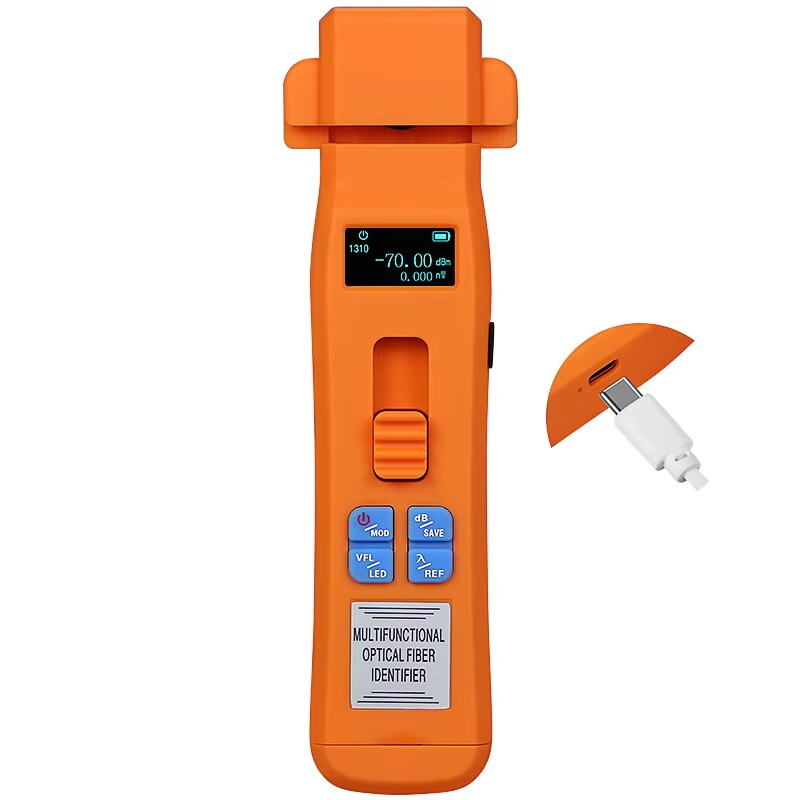Comprendre les identifiants de fibre et leur importance dans la détection de signal
Les identifiants de fibre jouent un rôle très important dans les travaux de télécommunications, agissant essentiellement comme de petits détecteurs vérifiant la présence d'une lumière circulant dans les fibres optiques, sans perturber les données déjà en transit. Les techniciens travaillant sur des réseaux à fibres optiques trouvent ces dispositifs particulièrement utiles lorsqu'ils doivent identifier précisément la fibre sur laquelle intervenir, notamment dans ces installations complexes comportant des dizaines de câbles partant dans toutes les directions. Lorsqu'un problème survient sur le réseau, disposer de cet outil fait toute la différence. Les techniciens peuvent localiser les pannes bien plus rapidement, sans risquer de couper la mauvaise ligne ou d'interrompre le service pour les clients dépendant d'une connectivité constante. Cela permet d'économiser du temps, réduit les frustrations et contribue au bon fonctionnement des entreprises pendant les opérations de maintenance.
En matière de détection de signaux, les identificateurs de fibres jouent un rôle essentiel pour garantir une transmission fiable des données. Ces dispositifs permettent aux techniciens d'identifier précisément les signaux optiques sans avoir à manipuler physiquement les câbles, ce qui contribue à réduire les pertes de signal et à maintenir les lignes de communication en bon état de fonctionnement. Il est très important de faire les choses correctement, car même de petites erreurs peuvent entraîner des déconnexions imprévues et endommager l'équipement, ce qui génère des coûts de réparation élevés et des interruptions de service. C'est pourquoi la plupart des équipes de maintenance réseau s'appuient fortement sur les identificateurs de fibres pour assurer une exploitation sans accroc de leurs systèmes et éviter ces pannes de communication frustrantes, particulièrement lors des opérations critiques.
À quel point est-il précis un Identifiant de fibre pour détecter les signaux lumineux ?
La performance d'un identificateur de fibre optique pour détecter les signaux dépend en réalité de plusieurs facteurs. Tout d'abord, la technologie utilisée – qu'elle soit active ou passive – joue un rôle très important. Ensuite, la qualité de fabrication de l'appareil lui-même est déterminante, car les modèles bon marché sont tout simplement moins fiables. Sans oublier l'utilisateur qui manipule l'outil : l'expérience compte beaucoup pour obtenir des résultats précis. Selon des études, les meilleurs identificateurs de fibres atteignent environ 95 % de taux de précision lorsque utilisés correctement par du personnel formé. Obtenir des résultats fiables est particulièrement important dans les configurations complexes de réseaux à fibres optiques. Une détection précise des signaux dès le départ permet d'économiser de longues heures de dépannage ultérieur pour les techniciens réseau.
Les plages de détection des identifiants de fibre ne sont pas des valeurs fixes ; elles varient selon des facteurs tels que la puissance du signal, le type de fibre utilisé et l'environnement environnant. La plupart du temps, ces outils fonctionnent très bien sur de courtes distances, lorsque le signal reste suffisamment fort pour être correctement lu. Toutefois, des problèmes surviennent lorsqu'on tente de détecter des signaux sur de plus longues distances, à cause d'un phénomène appelé atténuation : en résumé, le signal s'affaiblit au fur et à mesure qu'il se propage dans le câble. Cela signifie que les techniciens réseau doivent choisir leur matériel avec soin, en fonction des conditions attendues sur le terrain. Une bonne sélection fait toute la différence entre un dépannage réussi et des heures perdues à chercher des problèmes imaginaires dans des réseaux fibreux complexes.
Facteurs affectant la précision dans la détection des signaux de fibre
La détection des signaux fibre dépend de plusieurs facteurs, à commencer par le type de signal avec lequel nous travaillons. Les signaux en onde continue (Continuous Wave ou CW) se comportent différemment des signaux modulés en matière de méthodes de détection. La plupart des outils d'identification des fibres ont en réalité des difficultés à traiter correctement les signaux modulés, car leur intensité varie constamment. Le problème réside dans le fait que ces signaux fluctuent fortement en amplitude, rendant ainsi très complexe l'établissement de niveaux de détection fiables. Nous avons personnellement observé des mesures incohérentes apparaissant fréquemment précisément parce que l'équipement ne parvenait pas à suivre les variations constantes de l'intensité des signaux.
Le choix entre la fibre monomode et multimode a une réelle importance pour les performances du réseau. Lorsque quelqu'un a besoin d'une grande bande passante ou souhaite que les signaux parcourent de longues distances sans perte de qualité, la fibre monomode devient l'option privilégiée. Ces fibres permettent à la lumière de se propager en ligne droite avec un minimum d'interférences, ce qui signifie une meilleure détection du signal et moins d'erreurs sur de longues distances. Les fibres multimodes racontent cependant une histoire différente. Leurs cœurs plus larges provoquent en effet des problèmes appelés dispersion modale, où la lumière se disperse pendant sa propagation. Cette dispersion perturbe la clarté du signal et rend la détection moins précise, particulièrement sur de plus longues distances. Les concepteurs de réseaux doivent donc évaluer soigneusement ces facteurs en fonction des besoins réels de leurs systèmes.
L'environnement autour d'eux joue un rôle important dans l'efficacité des identificateurs de fibre. Les variations de température, les signaux indésirables provenant d'appareils électroniques à proximité, ainsi que tout obstacle sur le trajet entre l'appareil et la fibre perturbent leur capacité à fournir des mesures précises. La plupart des tests sur le terrain montrent que ces appareils fonctionnent beaucoup mieux lorsqu'ils sont installés dans des zones où les conditions restent relativement stables. Prenons par exemple la stabilité thermique : elle permet de maintenir constantes les propriétés de courbure de la lumière dans la fibre, ce qui est essentiel pour obtenir des mesures exactes. Ainsi, pour obtenir des résultats fiables avec un identificateur de fibre, il est nécessaire de trouver des moyens de réduire ces influences extérieures qui perturbent le fonctionnement approprié.
Amélioration de la précision des identifiants de fibres
Obtenir de meilleurs résultats avec les identificateurs de fibre signifie suivre quelques consignes de base mais importantes. L'entretien régulier est ici déterminant : garder ces appareils propres et correctement calibrés contribue grandement à assurer leur bon fonctionnement lorsque cela est nécessaire. L'environnement dans lequel ces outils sont utilisés a également son importance. La plupart des fabricants recommandent de travailler dans des endroits dont la température est stable et de s'éloigner des sources de bruit électromagnétique telles que les machines à proximité ou les équipements sans fil. N'oubliez pas non plus de vérifier la qualité de la connexion entre l'identificateur et la fibre testée. Une connexion faible entraîne souvent divers problèmes, allant jusqu'à des mesures complètement erronées ou des retards frustrants qui font perdre un temps précieux lors d'opérations critiques.
Il est essentiel d'assurer une calibration correcte des identifiants de fibre pour garantir leur précision. Lorsque nous vérifions régulièrement ces appareils à l'aide de matériaux de référence standard, leur précision se maintient beaucoup plus longtemps. Une approche courante consiste à exécuter des échantillons tests en parallèle avec des références du secteur afin de détecter tout décalage dans les performances. Ce type de maintenance permet à l'équipement de fournir des mesures fiables jour après jour. Sans bonnes pratiques de calibration, ces petites incohérences peuvent s'accumuler jusqu'à ce que les signaux des fibres soient complètement mal interprétés, entraînant divers problèmes en aval dans les opérations réseau.
Choisir le bon modèle d'identificateur de fibre pour une tâche spécifique est très important. Par exemple, une tâche simple comme vérifier les connexions lors d'une maintenance régulière nécessite des fonctionnalités différentes de celles requises pour diagnostiquer des problèmes dans des réseaux complexes. Lorsque l'on sélectionne un modèle qui correspond réellement aux besoins spécifiques, cela fait toute la différence en termes de précision et d'efficacité des identificateurs de fibre. Faire le bon choix améliore les performances globales et s'assure que les techniciens ne soient pas contraints d'utiliser du matériel inadapté à leurs besoins réels.
Conclusion : La précision des identificateurs de fibres dans la détection des signaux de fibre
La précision des identifiants de fibre dépend de plusieurs facteurs différents. Le type d'appareil considéré a une grande importance, tout comme le lieu d'utilisation et le niveau d'expérience de la personne qui l'opère. Prenons cet exemple : lorsqu'un technicien expérimenté utilise un équipement de bonne qualité dans des conditions favorables, il obtient généralement de meilleurs résultats par rapport à quelqu'un qui n'a pas les compétences nécessaires ou qui utilise du matériel de moindre qualité. C'est pour cela qu'il est si important de bien comprendre tous ces facteurs afin de pouvoir détecter efficacement les signaux des fibres dans des situations réelles.
L'avenir semble prometteur pour la technologie d'identification des fibres grâce à de nouvelles avancées comme l'apprentissage automatique, qui commence à marquer des points dans ce domaine. À mesure que ces innovations se développent, nous devrions observer des résultats améliorés en matière de précision et de fiabilité du fonctionnement des identifiants de fibres. Lorsque ces derniers évoluent au rythme des technologies de pointe, ils deviennent plus performants pour capter les signaux de fibres complexes, ce qui implique des réseaux optiques plus solides et fiables dans leur ensemble. Force est d'admettre que cela a une grande importance actuellement, les réseaux fibreux connaissant une croissance rapide et devenant de plus en plus complexes, notamment en raison de l'engouement autour de l'intégration des systèmes 5G et de l'expansion de la connectivité IoT dans les différents secteurs industriels.
FAQ
Qu'est-ce qu'un identificateur de fibres ?
Un Identifiant de Fibre est un appareil utilisé en télécommunications pour détecter la présence de lumière dans les fibres optiques sans interrompre le signal, aidant ainsi à l'entretien et à la résolution des problèmes.
Comment un Identifiant de Fibre améliore-t-il la fiabilité de la détection des signaux ?
En détectant précisément les signaux optiques sans interruption, les identificateurs de fibres aident à minimiser la perte de signal, à maintenir l'intégrité de la ligne de communication et à réduire les déconnexions accidentelles.
Quels facteurs affectent la précision des identificateurs de fibres ?
Des facteurs tels que le type de signal, le type de fibre, les conditions environnementales et la technologie utilisée dans l'appareil lui-même influencent la précision des identificateurs de fibres.
Comment peut-on améliorer la précision des identificateurs de fibres ?
Une maintenance régulière, une calibration et le choix du bon modèle pour des tâches spécifiques peuvent améliorer la précision des identificateurs de fibres. Les utiliser dans des conditions environnementales stables améliore également leur performance.
Table des Matières
- Comprendre les identifiants de fibre et leur importance dans la détection de signal
- À quel point est-il précis un Identifiant de fibre pour détecter les signaux lumineux ?
- Facteurs affectant la précision dans la détection des signaux de fibre
- Amélioration de la précision des identifiants de fibres
- Conclusion : La précision des identificateurs de fibres dans la détection des signaux de fibre
- FAQ







